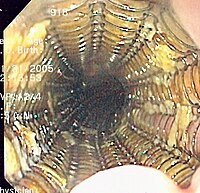
Photo from wikipedia
Benign oesophageal strictures (BOS) are common and are most often managed with endoscopic balloon or bougie dilation. While self-expanding stents (SES) are a key tool for managing malignant strictures, their… Click to show full abstract
Benign oesophageal strictures (BOS) are common and are most often managed with endoscopic balloon or bougie dilation. While self-expanding stents (SES) are a key tool for managing malignant strictures, their role in management of BOS is less well defined, usually being reserved for refractory strictures. Potential benefits include reduced frequency of intervention to stabilise nutritional status, and risks include migration, perforation or erosion. We conducted a single-centre retrospective review of our experience using SES for BOS to evaluate their safety and efficacy. All patients undergoing SES insertion at a tertiary oesophago-gastric surgery unit between November 2015 and November 2020 were retrospectively identified using cross-referencing across 3 internal software systems. Patients undergoing primary SES insertion for BOS were identified, records were retrieved and reviewed. Data was collected on pre-insertion stricture management, post-procedure complications and outcomes including further interventions within the next year. During the study period, 425 oesophageal SES were inserted. From these cases, 18 patients underwent primary SES insertion for BOS. 14/18 (78%) of patients were male with a mean age of 68 years. Causes of BOS were reflux (7, 39%), 360 degree radiofrequency ablation of dysplastic Barrett's oesophagus (7, 39%), radiotherapy for squamous cell carcinoma (2, 11%), post-achalasia treatment stricture (1, 6%) and anastomotic stricture (1, 6%). In the 12 months prior to SES insertion, patients underwent a median of 3 (IQR 2–4) balloon dilations. During the immediate preceding month, patients underwent a median of 1 (IQR 0–1) dilations. There were no cases of perforation, bleeding or erosion associated with SES insertion. 5 of 18 (28%) stents migrated. Median interval to the next endoscopy was just over 5 weeks (36 days (IQR 27.25–48). During the following 12 months after stent insertion, patients underwent a median of 5 (IQR 3–9.5) further endoscopies after primary stent insertion. Stent insertion for BOS is safe and can provide a period of several weeks before further intervention is required. This may facilitate a period during which oral nutrition can be improved. However, SES for BOS is associated with a significant rate of migration, and patients continue to require frequent interventions after stent insertion. We suggest that SES insertion in this setting should be reserved for selected cases where intensive early dilation has failed to achieve progression in diameter with improvement in symptoms and nutrition as part of a standardised approach to improve management of BOS.
Journal Title: British Journal of Surgery
Year Published: 2022
Link to full text (if available)
Share on Social Media: Sign Up to like & get
recommendations!